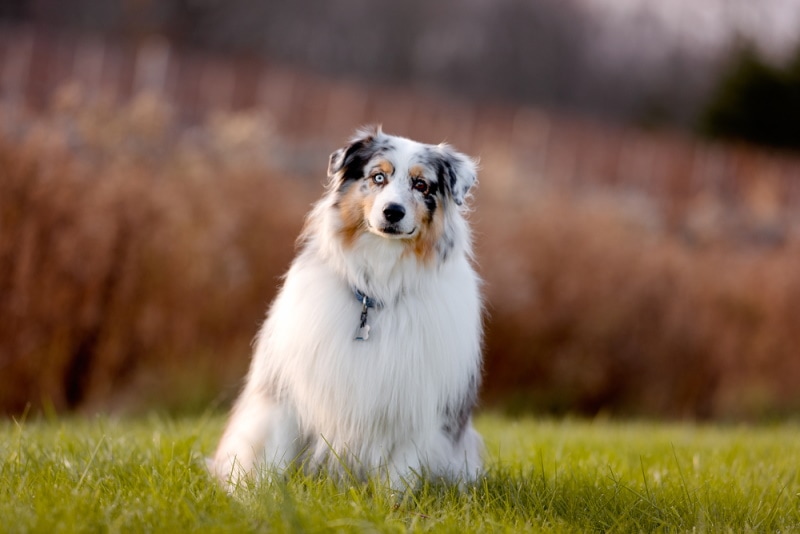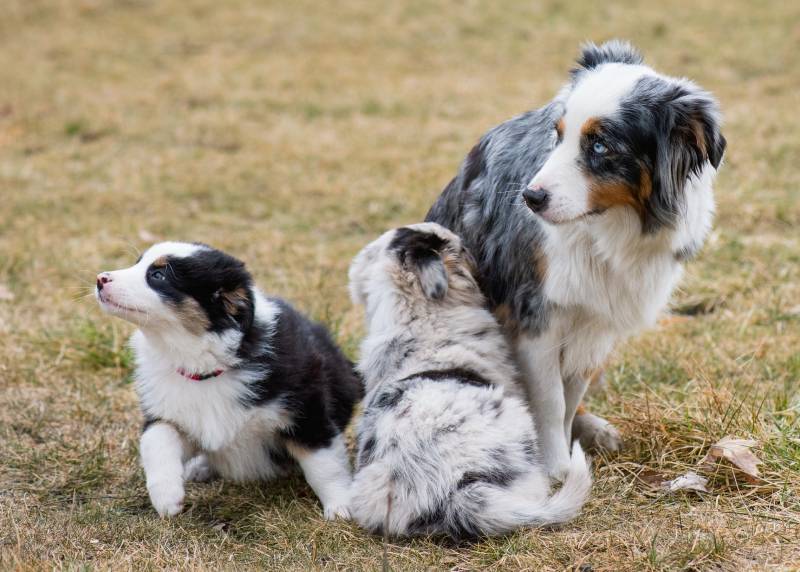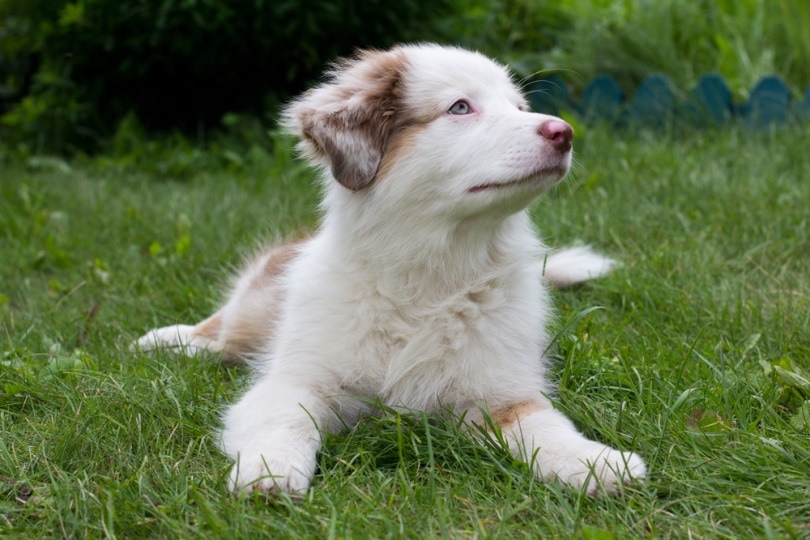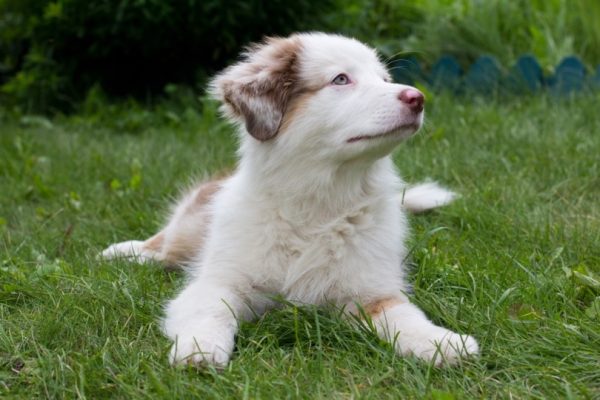Click to Skip Ahead
In many active, dog-loving families around the world, you’ll find an Australian Shepherd. These energetic dogs have a true zest for life and bring a real sense of fun to their families. White Australian Shepherds have been the subject of intrigue due to their purely white coats, which come about when a dog inherits double M (MM) genes from their parents.
Breed Overview
Height
18–23 inches
Weight
35–70 pounds
Lifespan
13–15 years
Colors
Black, red, merle, red merle, blue merle, tricolor
Suitable for
Homes with yards, families with and without kids
Temperament
Friendly, loyal, affectionate, playful, intelligent, trainable
Appearances aside, white Australian Shepherds are no different from their more colorful brothers and sisters, and they all have a story to tell. In this post, we’ll explore the history of white Australian Shepherds and why they’re such popular family dogs today.
Australian Shepherds Characteristics

The Earliest Records of White Australian Shepherds in History
Despite what their name suggests, Australian Shepherds were bred and developed in the western United States (Idaho, Colorado, Wyoming, California, etc.) in the late 19th century. They were bred from European herding dogs, which started arriving in America with Spanish conquistadors in the 16th century.
Among these herding dogs was the Carea Leonés from León, which is probably an ancestor of the Australian Shepherd. It is thought that the Carea Leonés is a likely ancestor because these dogs share many similar traits with the Australian Shepherd—a medium-length merle coat and (sometimes) blue eyes.
In the 19th century, the California Gold Rush meant that more sheep needed to be imported to the U.S., and, as a result, more herding dogs were required.

Among the dogs sent to tend the new influx of sheep were English Shepherds with Collie ancestry, which were typically merle and so-called “Australian Shepherds” (also likely derived from British dogs) that had accompanied the sheep imported from Australia. This is where the breed’s name comes from.
The Cell Reports Study conducted in 2017 concluded that Australian Shepherds are derived from British herding dogs, but it’s also clear that the Australian Shepherd is a real mashup of cultures all in one high-energy, beautifully-colored bundle. It is this cultural mixed bag that makes the breed so “American”.
How White Australian Shepherds Gained Popularity
Having proved themselves capable working dogs, Australian Shepherds started as invaluable farm and ranch dogs. They later grew in popularity as a result of appearing in Rodeos. There, they made themselves useful by herding bulls but also entertained the crowd with tricks, which brought them to the attention of the general public.
White Australian Shepherds are rarer than standard-colored Aussies, so you won’t see as many as them despite how popular the breed is.
Furthermore, the fact that the gene that results in a white Aussie is incorrectly referred to as the “lethal white gene” is harmful to their popularity and reputation. The lethal white gene is real, but it occurs in horses and is often fatal. White Australian Shepherds, on the other hand, are white due to the double merle gene and are perfectly capable of living long and happy lives.
This misconception may have damaged the white Aussie’s popularity due to the controversy surrounding their genetics.

Formal Recognition of White Australian Shepherds
Australian Shepherds were first officially recognized by the American Kennel Club in 1991. However, the AKC does not list white among its accepted breed standard colors, which are black, blue merle, red, and red merle. Certain white markings are acceptable, however, along with tan points.

Top 3 Unique Facts About White Australian Shepherds
1. White Australian Shepherds Have Double Merle Genes
Contrary to popular belief, white Australian Shepherds (homozygous merles) do not have the lethal white gene. They inherit a double merle gene from two standard merle parents. The odds of this happening are 25% per Australian Shepherd litter. Sadly, white puppies are sometimes killed due to a lack of understanding about what actually causes them to be white.

2. Different Colored Eyes Are Common in Aussies
Whatever their coat color, it’s not unusual to see an Australian Shepherd with two different colored eyes. This is known as heterochromia.
3. White Australian Shepherds Are Sometimes Born Deaf or Blind
Though there is a higher possibility that a white Australian Shepherd will be born deaf, blind, or both, these are not fatal conditions and do not prevent a white Aussie from living a full and happy life.

Does a White Australian Shepherd Make a Good Pet?
Very much so! Australian Shepherds of any color make great family dogs. These sharp, hardworking, and energetic dogs tend to thrive in active families that enjoy outdoor pursuits, as they have a real sense of adventure and love nothing more than keeping busy.
An Australian Shepherd with not enough to do quickly becomes bored and may act out destructively—these are certainly not the kinds of dogs that enjoy lounging around for most of the day.
They make great companions and playmates for sensible children—older children in particular. The Australian Shepherd’s strong herding instincts may result in them attempting to “herd” small children, though there are training methods aimed at reducing this behavior.

Conclusion
The Australian Shepherd’s history is a long and fascinating one, one spent mostly hard at work on farms, ranches, and in rodeos—a work ethic they’ve never lost. The popularity of these quick, spunky dogs has grown over the years. Australian Shepherds have been in the top 20 most popular dog breeds on the AKC’s list since 2014, and it’s not hard to see why!
- Related Read: 10 Essential Australian Shepherd Supplies
Featured Image Credit: Elena Birkina, Shutterstock







